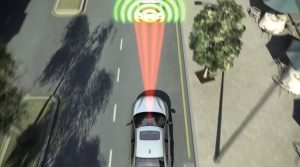Overview
Automated vehicle safety technologies signal the next revolution in roadway safety. We see great potential in these technologies to save lives—more than 30,000 people die on our roads every year and we can tie 94 percent of crashes to human choice—transform personal mobility and open doors to communities that today have limited mobility options.
The DOT Federal Automated Vehicles Policy sets the framework for the safe and rapid deployment of these advanced technologies.
COMPONENTS AND DEVELOPMENT
POLICY FACT SHEET
FEDERAL AUTOMATED VEHICLES POLICY OVERVIEW
The Federal Automated Vehicles Policy sets out a proactive safety approach that will bring lifesaving technologies to the roads safely while providing innovators the space they need to develop new solutions. The Policy is rooted in DOT’s view that automated vehicles hold enormous potential benefits for safety, mobility and sustainability.
The primary focus of the policy is on highly automated vehicles (HAVs), or those in which the vehicle can take full control of the driving task in at least some circumstances. Portions of the policy also apply to lower levels of automation, including some of the driver-assistance systems already being deployed by automakers today.
COMPONENTS OF THE POLICY
OFFICIAL NOTICES
ENFORCEMENT GUIDANCE BULLETIN ON AUTOMATED VEHICLE TECHNOLOGIES
REQUEST FOR COMMENT ON FEDERAL AUTOMATED VEHICLE POLICY
REQUEST FOR PUBLIC COMMENT ON PROPOSED COLLECTION OF INFORMATION (PRA)
- Vehicle Performance Guidance for Automated Vehicles: The guidance for manufacturers, developers and other organizations outlines a 15 point “Safety Assessment” for the safe design, development, testing and deployment of automated vehicles.
- Model State Policy: This section presents a clear distinction between Federal and State responsibilities for regulation of HAVs, and suggests recommended policy areas for states to consider with a goal of generating a consistent national framework for the testing and deployment of highly automated vehicles.
- Current Regulatory Tools: This discussion outlines DOT’s current regulatory tools that can be used to accelerate the safe development of HAVs, such as interpreting current rules to allow for greater flexibility in design and providing limited exemptions to allow for testing of nontraditional vehicle designs in a more timely fashion.
- Modern Regulatory Tools: This discussion identifies potential new regulatory tools and statutory authorities that may aid the safe and efficient deployment of new lifesaving technologies.
FEDERAL POLICY
Performance
FOR MANUFACTURERS
VEHICLE PERFORMANCE
VEHICLE PERFORMANCE GUIDANCE FACT SHEET
The Vehicle Performance Guidance for Automated Vehicles (“Guidance”) outlines best practices for the safe design, development and testing of automated vehicles prior to commercial sale or operation on public roads. The Guidance includes a 15-Point Safety Assessment to set clear expectations for manufacturers developing and deploying automated vehicle technologies. For companies, the Guidance describes internal processes and strategies, organizational awareness, record-keeping, testing and validation, engagement with DOT and NHTSA, and improved transparency to support the safe deployment of HAV technology. The industry’s adoption and use of the Guidance, which DOT and NHTSA will review annually and update as necessary, will build public confidence and maintain the U.S. lead on these emerging automotive safety technologies.
FEDERAL POLICY
State Policy
ROLES
MODEL POLICY
State governments play an important role in facilitating automated vehicles, ensuring they are safely deployed and promoting their life-saving benefits. The Model State Policy confirms that States retain their traditional responsibilities for vehicle licensing and registration, traffic laws and enforcement, and motor vehicle insurance and liability regimes while outlining the Federal role for automated vehicles. The Model State Policy supports the establishment of a consistent national framework of laws and policy to govern automated vehicles.
STATE RESPONSIBILITIES:
- Licensing (human) drivers and registering motor vehicles in their jurisdictions;
- Enacting and enforcing traffic laws and regulations;
- Conducting safety inspections, when States choose to do so; and
- Regulating motor vehicle insurance and liability.the next revolution in roadway safety.
FEDERAL POLICY
Regulation
CURRENT TOOLS
CURRENT REGULATORY TOOLS
CURRENT REGULATORY TOOLS FACT SHEET
Learn about existing regulatory tools that NHTSA will use to promote the safe development and deployment of automated vehicles, including interpretations, exemptions, notice-and-comment rulemaking, and defects and enforcement authority. NHTSA has streamlined its review process and is committing to expediting simple automated vehicle-related interpretations and exemption requests.
MODERN TOOLS
MODERN REGULATORY TOOLS
MODERN REGULATORY TOOLS FACT SHEET
We’ve identified potential new tools, authorities and resources that could aid the safe deployment of automated technologies by enabling DOT to be more nimble and flexible. Some of the identified tools could be created under current law while others would require Congressional action. Today’s governing statutes and regulations were developed before automated vehicle technologies were even a remote notion. Current authorities and tools alone may be insufficient to ensure the safe introduction and full safety promise of new technologies. This challenge requires DOT and NHTSA to examine whether the ways in which the Agency has addressed safety for the last several decades should be expanded to realize the safety potential of automated vehicles over the decades to come.
